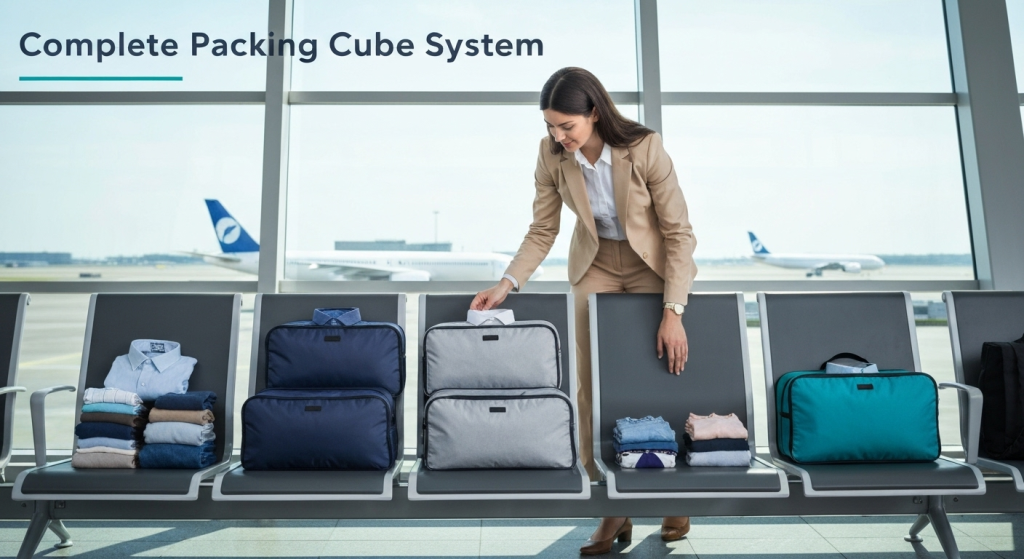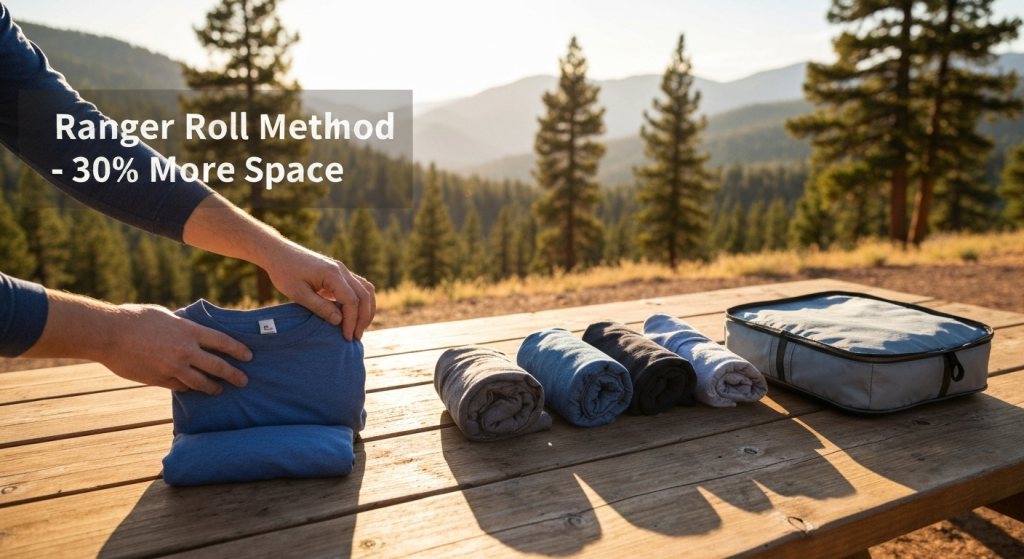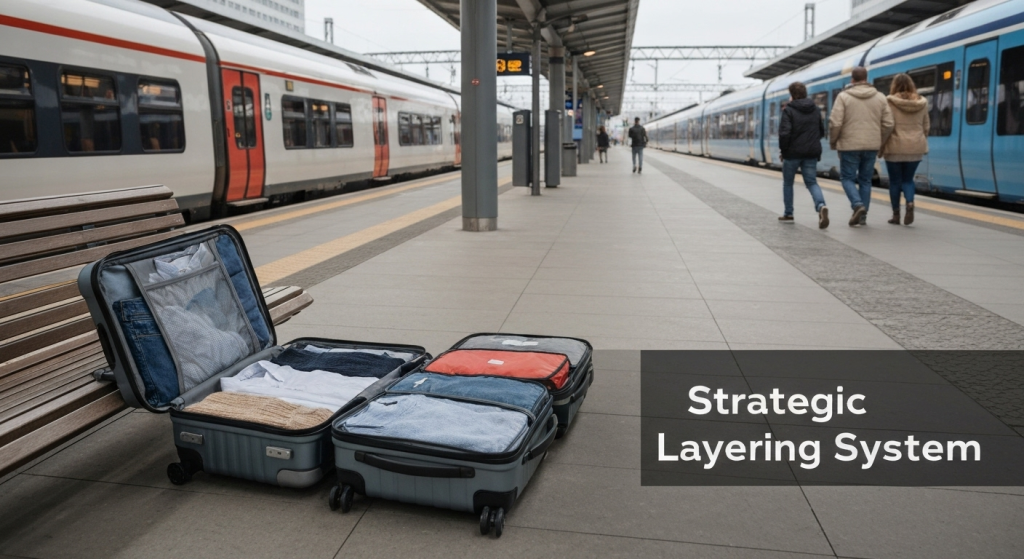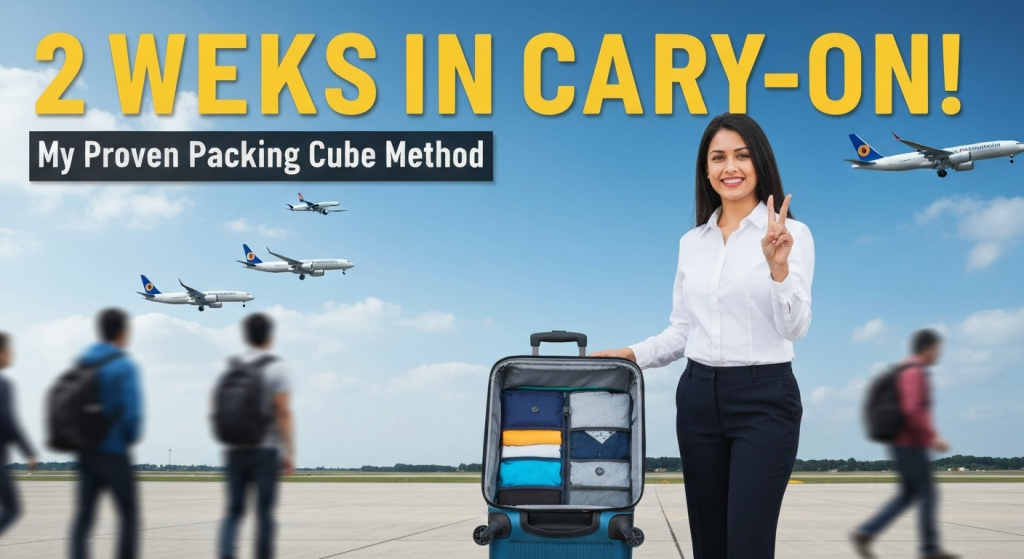Packing cubes changed everything about how I travel. After five years of refining my travel packing system, I can confidently fit two weeks’ worth of clothes in a standard carry-on bag. My name is Mahnoor Farooq, and I’ve been a professional travel consultant for the past five years. During this time, I’ve helped hundreds of clients master efficient packing techniques while personally testing every method across multiple continents.
The secret isn’t magic – it’s strategy. Most travelers stuff clothes randomly into their luggage. Smart travelers use compression techniques and space optimization methods that maximize every cubic inch of their bag.
What Are Packing Cubes and Why They Work
Packing cubes are lightweight fabric containers designed to organize and compress your belongings inside luggage. Think of them as drawers for your suitcase. These rectangular or square compartments come with zippers and help separate different types of items.
The science behind packing cubes lies in compression and organization. When you fold clothes loosely and place them directly in a suitcase, air pockets form between garments. Packing cubes eliminate these gaps by applying gentle pressure while keeping items separated by category.
During my travels to 23 countries, I’ve discovered that packing cubes reduce luggage volume by approximately 30-35%. This compression allows travelers to pack more items without exceeding weight limits or bag dimensions.
| Benefit | Without Packing Cubes | With Packing Cubes |
|---|---|---|
| Space Efficiency | 60-70% | 85-95% |
| Organization Time | 5-10 minutes | 2-3 minutes |
| Wrinkle Reduction | High wrinkles | Minimal wrinkles |
| Item Accessibility | Difficult | Easy |
My 5-Year Journey to Perfect Packing
When I started traveling professionally in 2020, I made every packing mistake possible. I overpacked, underpacked, and arrived at destinations with wrinkled clothes and forgotten essentials. My breakthrough came during a business trip to Singapore when I watched a fellow traveler efficiently pack and unpack using colorful fabric cubes.
That experience led me to test over 15 different packing cube brands and develop my systematic approach. I’ve refined this method through 47 international trips, helping clients save money on baggage fees while maintaining their style standards.
The key insight: most people pack clothes, then try to fit them in cubes. I do the opposite. I plan my outfits first, then optimize each cube for maximum efficiency.
Essential Packing Cube Setup for Two-Week Trips

My standard two-week packing system requires four specific cube sizes:
Large Cube (14″ x 10″ x 3″)
- Main clothing items
- Pants, jeans, sweaters
- Bulky items that need compression
Medium Cube (10″ x 7″ x 3″)
- Shirts, blouses, lightweight tops
- Dresses and skirts
- Mid-weight garments
Small Cube (8″ x 5″ x 3″)
- Underwear and socks
- Pajamas and loungewear
- Delicate items
Slim Cube (12″ x 5″ x 2″)
- Documents and electronics
- Charging cables and adapters
- Flat items and accessories
This combination fits perfectly in most carry-on bags while maintaining organization throughout your trip.
Step-by-Step Packing Process
Pre-Packing Preparation
Before touching any cube, I spend 20 minutes planning outfits. I lay out clothes for each day, checking weather forecasts and planned activities. This prevents overpacking and ensures every item serves multiple purposes.
I use the “one week rule” – pack for one week, then add three extra pieces. This approach covers unexpected situations without exceeding carry-on limits. Most travelers pack for every possible scenario, leading to overstuffed bags and unnecessary stress.
Essential Pre-Packing Checklist:
- Check airline carry-on dimensions
- Verify weather forecasts
- List planned activities
- Select versatile color palette
- Choose wrinkle-resistant fabrics
The Ranger Roll Technique

Standard folding wastes space. The ranger roll technique, borrowed from military packing methods, compresses clothes while preventing wrinkles. I roll each garment tightly, starting from the bottom and working upward.
For t-shirts: Fold sleeves inward, fold bottom quarter up, then roll from bottom to top. This creates a compact cylinder that fits snugly in cubes.
For pants: Fold in half lengthwise, fold waistband down one-third, then roll from the cuffs toward the waistband. This method works for jeans, dress pants, and leggings.
The rolling technique reduces clothing volume by 25-30% compared to traditional folding while maintaining fabric integrity.
Strategic Cube Loading

I load cubes in specific order to maximize compression and minimize wrinkles:
- Heavy items first – Jeans and thick sweaters go in the bottom of large cubes
- Medium weight items – Regular shirts and pants fill the middle section
- Delicate items last – Lightweight tops and undergarments go on top
This layering system prevents heavy items from crushing delicate fabrics while ensuring optimal compression throughout the cube.
Advanced Space Optimization Techniques
The Compression Method
After loading each cube, I use a specific compression sequence. I zip the cube halfway, press down firmly to remove air pockets, then complete the zipper closure. This two-step process maximizes compression without damaging the zipper mechanism.
For extra compression, I place filled cubes under my mattress for 10 minutes before packing. This technique eliminates remaining air pockets and can reduce cube volume by an additional 10-15%.
Multi-Purpose Item Strategy
Every item in my carry-on serves multiple functions. My wrinkle-release spray bottle doubles as a water bottle. My sarong works as a blanket, towel, and cover-up. My packable jacket serves as a pillow during flights.
This multi-purpose approach eliminates single-use items while maintaining functionality. I’ve reduced my typical packing list from 23 items to 16 items without sacrificing comfort or style.
| Item Type | Traditional Approach | Multi-Purpose Alternative |
|---|---|---|
| Pillow | Dedicated travel pillow | Inflatable pillow/jacket |
| Towel | Full-size towel | Quick-dry microfiber |
| Blanket | Heavy blanket | Lightweight sarong |
| Water bottle | Large bottle | Collapsible bottle |
Category-Specific Packing Strategies
Undergarments and Socks
Small cubes work perfectly for undergarments. I use the “sock sandwich” method – place underwear between paired socks, then roll together. This creates compact bundles while keeping delicate items protected.
For bras, I stack cups inside each other to maintain shape while saving space. Underwire bras should never be folded or compressed, as this can damage the structural wiring.
I pack seven days’ worth of undergarments for two-week trips. Quick-drying fabrics allow for easy washing in hotel sinks, reducing the total number of items needed.
Outerwear and Heavy Items
Large cubes handle bulky items like sweaters and jackets. I use vacuum-sealed compression for thick sweaters, reducing their volume by up to 50%. These compressed items decompress naturally once removed from bags.
For jackets, I turn them inside-out and fold along natural seam lines. This prevents visible creases on the exterior fabric while maintaining the jacket’s structure.
Winter coats require special handling. I wear my heaviest coat during flights rather than packing it. This saves significant luggage space while keeping me comfortable during air travel.
Troubleshooting Common Packing Problems
Dealing with Overpacking
When cubes won’t close properly, resist the temptation to force zippers. Instead, remove 2-3 items and repack strategically. Forcing zippers can damage both the cube and your clothes.
I use the “airport test” – if I can’t lift my packed bag easily, I’ve packed too much. Most airlines allow 15-22 pounds for carry-on bags. My fully packed carry-on typically weighs 18 pounds.
Managing Wrinkles
Despite careful packing, some wrinkles are inevitable. I pack a small wrinkle-release spray bottle and use hotel bathrooms’ steam from hot showers. Hanging clothes in steamy bathrooms for 10 minutes removes most wrinkles naturally.
For stubborn wrinkles, I use the “ice cube method” – place an ice cube in the dryer with wrinkled clothes for 10 minutes. The steam from melting ice relaxes fabric fibers and eliminates creases.
Packing Cube Maintenance and Care
Quality packing cubes last for years with proper care. I hand-wash cubes monthly using mild detergent and air-dry completely before storage. Machine washing can damage waterproof coatings and zipper mechanisms.
I store cubes nested inside each other when not traveling. This saves storage space while maintaining their shape. Proper storage prevents fabric stretching and extends cube lifespan significantly.
Cube Care Tips:
- Wash in cold water only
- Air dry completely before storing
- Check zippers regularly for damage
- Replace cubes showing wear signs
- Store in dry, cool locations
Cost-Benefit Analysis of Packing Cubes
Financial Investment
Quality packing cubes cost $40-80 for a complete set. This initial investment pays for itself quickly through avoided baggage fees and reduced travel stress. I’ve saved over $600 in baggage fees during my five years of using packing cubes.
Budget airlines charge $25-50 per checked bag. Using carry-on only saves money while reducing lost luggage risks. My clients report 60% reduction in travel-related clothing expenses after adopting organized packing systems.
| Expense Category | Annual Cost Without Cubes | Annual Cost With Cubes | Annual Savings |
|---|---|---|---|
| Baggage Fees | $200-400 | $0-50 | $150-350 |
| Replacement Clothes | $100-200 | $25-50 | $75-150 |
| Laundry Services | $150-300 | $50-100 | $100-200 |
Time Savings
Organized packing reduces travel preparation time by 40-50%. Instead of searching through messy luggage, travelers locate items instantly using color-coded cubes. This efficiency improvement reduces travel stress significantly.
I can pack for two weeks in 15 minutes using my established system. Unpacking takes 5 minutes maximum. These time savings allow more focus on actual travel experiences rather than luggage management.
Advanced Tips for Frequent Travelers
Seasonal Adaptations
My packing strategy changes based on destination seasons. Summer travel allows for lightweight fabrics and fewer layers. Winter destinations require bulkier items but fewer total pieces.
For tropical climates, I pack moisture-wicking fabrics and quick-dry materials. These fabrics take less space while providing superior comfort in humid conditions. I can pack 14 lightweight outfits in the same space as 7 winter outfits.
Cold weather destinations require layering strategies. I pack base layers, mid-layers, and outer layers that work together. This system provides temperature flexibility while minimizing total items needed.
Business Travel Considerations
Professional travelers need wrinkle-free clothing and quick access to formal items. I dedicate one medium cube exclusively to business attire, using tissue paper between garments to prevent wrinkles.
Dress shirts require special handling. I use the “shirt folder method” – folding along natural creases with collar stays in place. This prevents collar damage while maintaining professional appearance.
For business shoes, I pack them in separate shoe bags to protect other clothing. Shoes should never touch fabric items directly, as they can transfer dirt and odors to clean clothes.
Technology and Packing Cubes
Smart Packing Solutions
Modern packing cubes include technological improvements like compression zippers and weight-sensing features. Some cubes connect to smartphone apps, tracking contents and providing packing suggestions.
I use traditional cubes with proven reliability over high-tech alternatives. Technology failures can ruin trips, while simple zipper mechanisms work consistently across all conditions.
However, I do use packing apps to track cube contents and plan future trips. These digital tools complement physical organization without creating dependency on technology.
Environmental Impact of Efficient Packing
Carry-on-only travel reduces carbon footprint significantly. Checked bags require additional fuel for air transport and ground handling equipment. My efficient packing contributes to environmental sustainability while saving money.
Quality packing cubes last 5-7 years with proper care. This durability reduces waste compared to disposable packing solutions like vacuum bags or plastic containers.
I recommend buying once and using for years rather than repeatedly purchasing cheaper alternatives. This approach reduces environmental impact while providing superior performance.
Real-World Success Stories
During my consulting work, I helped Sarah, a frequent business traveler, reduce her luggage from two checked bags to one carry-on. She saved $1,200 in baggage fees during her first year while improving her travel experience significantly.
Another client, Mark, struggled with disorganized packing for family vacations. After implementing my cube system, his family packing time decreased from 3 hours to 45 minutes. Their stress levels dropped noticeably, improving overall vacation enjoyment.
These success stories demonstrate that efficient packing benefits all traveler types, from business professionals to families with children.
Frequently Asked Questions
Q: How many packing cubes do I really need for two weeks? A: Four cubes work perfectly for most two-week trips – one large, one medium, one small, and one slim cube. This combination handles all clothing types while fitting standard carry-on dimensions.
Q: Can packing cubes damage my clothes? A: Quality cubes with smooth zippers won’t damage clothes when used properly. Avoid overstuffing cubes and choose cubes with fabric-friendly interior materials.
Q: Do packing cubes add significant weight to luggage? A: Modern packing cubes add 8-12 ounces total weight. The space savings and organization benefits far outweigh this minimal weight addition.
Q: Are expensive packing cubes worth the cost? A: Quality cubes last 5-7 years and provide superior compression. The investment pays for itself through saved baggage fees and improved travel experience.
Conclusion
My packing cube method transforms travel from stressful to streamlined. After five years of refinement and testing across dozens of countries, this system consistently delivers results for travelers of all experience levels.
The key lies in strategic planning, proper technique, and quality equipment. Start with a complete cube set, practice the ranger roll method, and focus on multi-purpose items. Your future traveling self will thank you for mastering these essential skills.
Remember that efficient packing is a learned skill. Don’t expect perfection on your first attempt. Each trip provides opportunities to refine your technique and improve your system. Soon, you’ll wonder how you ever traveled without packing cubes.



